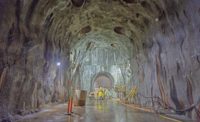The TBM launch chamber, a horseshoe-shaped cave that is 202 ft long, 47 ft wide and 38 ft tall, sits directly below the access shaft. Workers excavated it in top-heading and bench sections using drill-and-blast methods, with a lining of shotcrete and rock bolts for support. North of the launch chamber is the starter tunnel, a 360-ft-long, 26-ft horseshoe tunnel that was excavated by drill and blast. An umbrella canopy system was employed to allow for sequential excavation and to mitigate the adverse geological conditions in the area. Those conditions brought the project early challenges in the tunneling process.
Challenges UNDERGROUND
In July 2010, when preparing the starter tunnel, crews struck a geographical fault of water-heavy clays that resulted in heavy inflows of mud, water and clay. After months of pumping and attempting to firm the area with grout, that path was abandoned in early 2011.
"The project was not without its major challenges. One of the biggest was that the original alignment for the tunnel had to be moved about 23 degrees because a fault with clay-rich deposits was found," Moonin says.
As a result of the delay in the original alignment for the tunnel, the specifically designed, 23.6-ft-wide, 600-ft-long, multimode TBM supplied by Herrenknecht sat unassembled at the top of the access shaft for more than a year while planning and additional excavations were completed. The TBM was launched in late 2011 and, due to the hydrostatic pressure caused by water from the lake, it commonly operated in pressures of up to 15 bar.
"In close cooperation with the customer, we have configured the Las Vegas machine in such a way that we are well prepared for all possible situations," says Werner Burger, chief engineer at Herrenknecht. "Even though Vegas Tunnel Constructors did not have to pull out all the stops, it was good to know that they could have."
In open mode, a centrally located screw conveyor removes excavated material onto belt conveyors that then move the material along. The main chamber is sealed by closing the rear discharge gate in the event of a water in-rush. The TBM utilizes an envelope of air to control the support pressure while operating in closed mode. Three drills are typically used for probe drilling or pre-excavation grout. The change from open to closed mode can be completed in two minutes.
In both modes, the TBM would excavate and put in place concrete rings that lined and reinforced the excavated tunnel. Approximately 2,400 concrete rings were installed.
Jim Nickerson, project manager for Vegas Tunnel Constructors, says the unseen geologic conditions forced the crews—which included 100 people working 24 hours a day in three shifts—to operate the TBM in closed mode more often than anticipated.
"We had planned a maximum of 30% of tunnelling in the more difficult closed mode; it ended up being almost 60%," Nickerson says.





Post a comment to this article
Report Abusive Comment